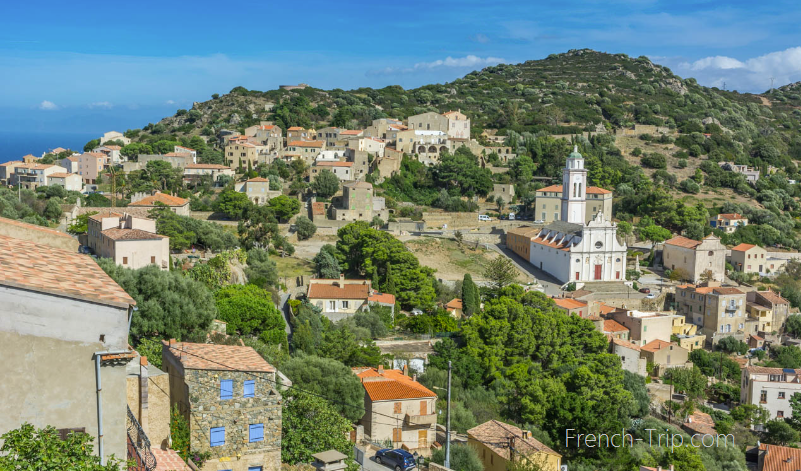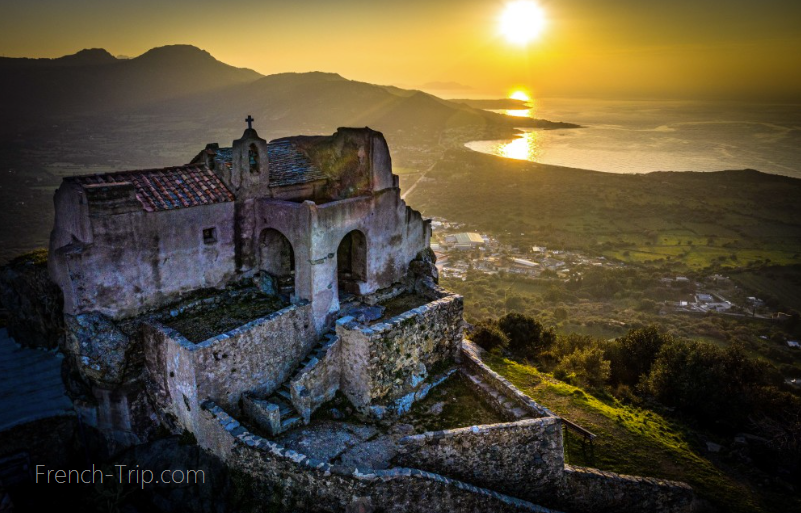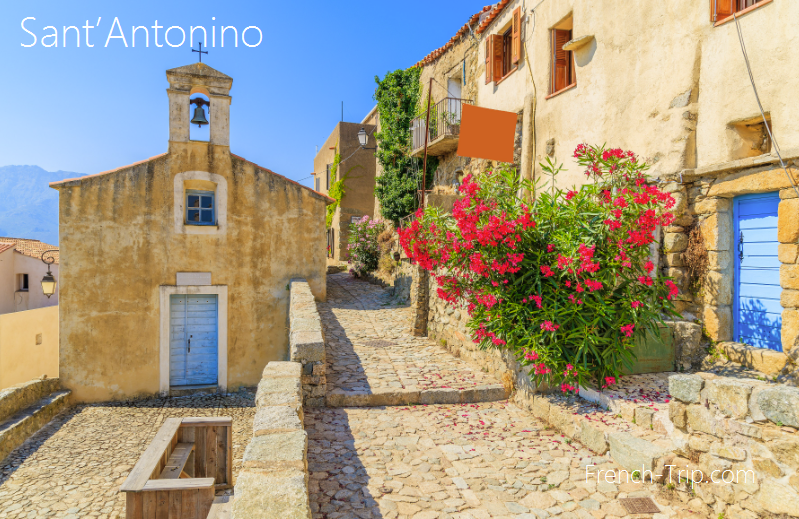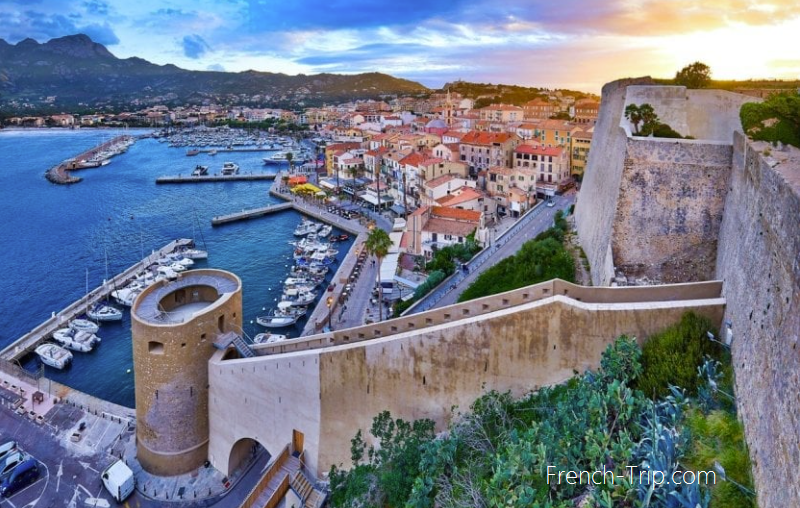Corbara

Corbara is a charming village in northwest Corsica, situated between Calvi and Ile Rousse, just a short distance from the coast. Once the historic capital of the Balagne region, Corbara lies at an altitude of 170 meters and offers visitors a wealth of history and culture. Highlights include a baroque church, a museum showcasing liturgical treasures, the ruins of a castle, and a 15th-century convent just outside the village. As with many Corsican villages, its winding alleys are perfect for exploring.
Corbara is one of the first villages you’ll encounter on a tour of Balagne. It can also be reached easily by following the coastal road, just a few kilometers away, making it a worthwhile stop.

Corbara Travel Guide
A visit to Corbara takes you into the heart of traditional “Moorish” architecture. Legend has it that a local woman, Davia, once became Empress of Morocco. As you stroll through the village, you’ll pass beautiful houses, navigate narrow streets, and wander under arched passages, all characteristic of a typical Balagne village.
Plan to spend at least an hour exploring, and since some streets are steep, comfortable shoes are a must. There are a few local restaurants where you can enjoy lunch during your visit.
Weather in Corbara:
Getting to Corbara
This picturesque village is best reached by car or motorbike. There is parking available near the collegiate church and town hall.
- Travel time from Calvi: 30 minutes
- Travel time from Ile Rousse: 15 minutes
Exploring Corbara
Corbara is actually a cluster of small villages scattered across the hills, though most can be reached on foot from the main part of town. As you explore, you’ll discover an impressive number of churches, including the Chapel of Notre-Dame des Sept Douleurs, the Church of the Nativity of the Virgin (Notre-Dame de Lazio), and various other chapels and oratories. The Monastery of Saint-Dominique is also a must-see.

Don’t miss the Collegiate Parish Church of A Nunziata, where you can visit the Museum-Treasury in the sacristy, which holds a collection of intricate liturgical decorations. For a deeper understanding of Corbara’s heritage, be sure to use the audio guide available at the entrance.
On your way to the village square, take a moment at the famous “di u sbollaru” fountain, located under a lovely archway. Legend has it that drinking from this spring brings peace to those who partake.
Finally, head to the top of the village to the Guy Savelli Museum. Here, you’ll find a fascinating collection of portraits, maps, handwritten letters, old posters, and ancient musical instruments, offering a glimpse into the rich history of the area.

Main Sights of Corbara
Wander through the village and reach the open-air belvedere in front of the pastel pink church.
Église-collégiale A Nunziata
This Baroque church of the Annunciation was built between 1641 and 1751. Inside, it is worth seeing the impressive altar, made of marble from a nearby quarry in the 18th century. By order of September 6, 1985, the temple was classified as a historical monument.
Next to the church of the Annunciation is the War Memorial.
Mont de Guido
This site includes the main historical remains of the town: the location of the Count’s Tower (Torra del conte), the 14th century fort of Count Mannone (U Fo), today the Notre-Dame-de-Saint-Douleurs chapel, the ruins of a 9th century castle built by Guido de Sabellis, the 16th century Saint-Jacques chapel.
Chapelle de Notre-Dame des Sept Douleurs
Corbara has several other small churches and chapels, and as you follow the streets of the village you will notice signs for the Chapelle de Notre-Dame des Sept Douleurs – French for Our Lady of the Seven Sorrows. It is an uphill walk, but its location and the views from the chapel are worth it. The temple was built in 1765 on the site of a 14th-century fort belonging to Count Mannone. The building was inaugurated on April 25, 1700 by Dominic Aitelli Savelli de Guido, a descendant of Guido de Savelli, who founded Corbara in 816.
Once inside, you will see a tiny chapel that can accommodate only about 20 people on four simple wooden benches.

Outside the chapel there is a view of the coast, as well as the village of Corbara. It is said that Pasquale Paolo, the leader of the movement for an independent Corsica in the 18th century, stood on this spot when he was deciding where to found a new city to compete with Calvi, the city that later became L’Île-Rousse.
The belvedere of the church offers a very wide view of the Balanine coast, from the Revellata peninsula to the borders of the city and L’Île-Rousse, the villages of Lavatoggio, Pigna and Sant’Antonino and Monte Grosso.

From here there are several alleys leading back to the village centre where you can see some small traditional houses.
There are several other small churches and chapels in and around Corbara, including the Chapel of Notre-Dame de Mazio near the monastery of Saint-Dominique, the Chapel of Saint-Cyprien, the Chapel of Saints Peter and Paul near the village and the Chapel of Saint-Jacques near the ruins of the castle.
The Monastery of Saint-Dominique de Corbara
It was built around 1430 on the slopes of Mount Saint-Ange (San’Anghjelu). It was originally called the couvent de Saint François de la Pieve d’Aregno. In 1861, the Italian Dominicans settled here following the Franciscans. Expelled in 1903 after the promulgation of the laws on the separation of church and state, the Dominicans returned there in 1927. They left in 1993. Since then, the monastery has been occupied by a new religious community, the Brothers of St. John. It is the most important monastery in Corsica. It also serves as a retreat for monks.
The entire monastery, the monastic buildings and the cloister, the church and the bell tower are included in the State Register of Historical Monuments by order of November 28, 2011.

Mount Saint-Ange
Monte San’Angelo dominates the monastery of Corbara. Here are the ruins of a castle built by Jacopino, son of Guido de Sabellis.
Chapel of the Nativity, known as the chapel of Notre-Dame de Lazio
Chapelle de la Nativité, chapelle Notre-Dame de Lazio. The Chapel of Our Lady of Lazio, located below the monastery of Saint-Dominique de Corbara, was built in 1765. It is a temple where religious ceremonies are held throughout the year. The most common are Maundy Thursday (Adoration of the Holy Sepulchre), July 2 (Mass in honour of Our Lady of Mercy), July 26 (Feast of Saint Anne), August 15 (Feast of the Assumption of the Lord – Mass followed by a procession), September 8 (transfer of the Feast of the Nativity of the Virgin to the following Sunday) and the end of September (closing ceremony, dedication of the Virgin, Mass and procession).
The building of the temple is listed as a historical monument. The list of historical monuments inside includes:
- A sculptural group of the Madonna and Child, called the Madonna di Lazio, made of painted marble, dating from 1481. Since the Second Empire, the statue has been dressed in a modest dress, which is removed only on the Feast of Our Lady of Lazio in early October.
- A bas-relief of the Virgin of Mercy made of sculptural marble from the 19th century.

Corbara Monolith
About 300 m north of the national road n° 197 as the crow flies and west of the town, you can still see the impressive monolithic porphyry column weighing over 270 tons, abandoned in a quarry in 1837. It was intended to serve as a support for a monumental statue of Napoleon I, which was never erected.
Corbara Museums
Corbara also has two small museums:
- The Museum of History and Ancient Art, a private museum run by Guy Savelli. It is located on the place de l’Église, 40 m from the main church of Corbara. Admission is free and visits are guided.
- The Treasury Museum is the Collegiate Church of the Nunziata. This is a museum of religious art which contains a large number of religious objects including paintings, priests’ clothes, silver objects, a statue made of Carrara marble, furniture including a canopy donated by Empress Eugenie, a wooden baptistery, etc. Open from April to October, Monday to Saturday.
To Eat in Corbara
There are 5 restaurants in Corbara, all with pretty good ratings, so you can choose any. The prices are also about the same. All restaurants serve French cuisine with a touch of Italian dishes.
- A Cantina is a relatively inexpensive restaurant, main dishes 15-22 €, salads 12-15 €. At the bottom of the village, terrace without a panoramic view. 301 Vla Sottana, 20256 Corbara
- Le Patio is a hotel restaurant with a panoramic terrace. Main dishes 18-24 €. 110 Borgo, 20256 Corbara
- U Furnellu Di Davia is a budget option: pizzas 12-13 €, Corsican specialties (cheese / meat plate) – 12-13 €. The highest rating on Google. The restaurant is located above the road where the cars park. The terrace overlooks the surrounding area and the road.
- Le Passage — Very tasty local food, friendly staff, a beautiful terrace under a fig tree at the bottom of the village. Interesting presentation and dishes, generous portions. Starters 12-16 €, main courses 18-26 €, desserts 9 €. In season: from 7am to 11pm. Vla Di Mezzo, 20256 Corbara
- Saetta — a family restaurant a few steps from the main square of Corbara. The menu is simple, changes every day and is based on fresh products. Beautiful view from the terrace, especially with a drink at sunset. Main courses around 20-25 €. Opening hours: 11am-2pm / 6pm-12pm.
Useful links:

Around Corbara
On the nearby coast you will find a long sandy beach at Algaiola. Further afield, it is worth visiting the beach of Ostriconi, near Ogliastro and about 15 kilometers northeast of Corbara.
If you are touring the Balagne villages, continue south on the D151 to Pigna, then continue on to Sant’Antonino, one of the most beautiful villages in Corsica.

Calvi
Clear waters, a rich heritage and a fantastic history make Calvi a true gem of the Island of Beauty. Read more…
Ostriconi
The beach of Ostriconi is located about 15 km from Ile Rousse in the direction of Bastia. It is one of the most beautiful beaches in Corsica, located at the entrance to the famous Agriate desert, known for its perfect coastline. Read more…
![]()
Zilia
If you look towards the mountains, you will see Monte Grosso, and it is here, at the foot of this mountain, that the village of Zilia was built.
Corbara on Corsica map:
Archives
Calendar
| M | T | W | T | F | S | S |
|---|---|---|---|---|---|---|
| 1 | 2 | 3 | 4 | 5 | 6 | 7 |
| 8 | 9 | 10 | 11 | 12 | 13 | 14 |
| 15 | 16 | 17 | 18 | 19 | 20 | 21 |
| 22 | 23 | 24 | 25 | 26 | 27 | 28 |
| 29 | 30 | 31 | ||||
